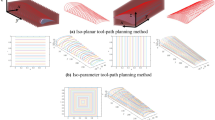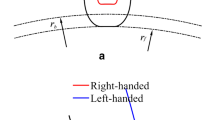Abstract
Twin-tool milling is a new method for turbine blade machining. The dorsal and basin surfaces are machined simultaneously, which can improve the machining efficiency obviously. However, its tool path planning becomes a major challenge due to the asymmetry of the blade surfaces and the structural constraints of the twin-tool machine. In this paper, an iso-parametric path-planning method is proposed for turbine blades milling with twin tools. Considering the structural constraints, the twin-tool orientations are characterized uniformly. In order to guarantee the smoothness of the tool paths, the calculating and equally parameterized fitting algorithm for the cutter contact (CC) points in each path is proposed. Furthermore, the opposite tool paths are matched with a self-defined ratio to realize the simultaneous milling for both blade surfaces. Finally, the tool paths are planned for a typical turbine blade based on the method. The results of simulation and verification experiments show that both blade surfaces are entirely machined. The contour errors can meet the tolerance requirements. In addition, the efficiency increases by about 45% compared with the single-tool milling of the equivalent cutting parameters.
Similar content being viewed by others
References
Wan XJ, Hua L, Wang XF, Peng QZ, Qin XP (2011) An error control approach to tool path adjustment conforming to the deformation of thin-walled workpiece. Int J Mach Tools Manuf 51:221–229
Bolsunovskiy S, Vermel V, Gubanov G, Kacharava I, Kudryashov A (2013) Thin-walled part machining process parameters optimization based on finite-element modeling of workpiece vibrations. Procedia CIRP 8:276–280
Krishnakumar K, Melkote SN (2000) Machining fixture layout optimization using the genetic algorithm. Int J Mach Tools Manuf 40:579–598
Zhang Z, Zhang D, Luo M, Wu B (2016) Research of machining vibration restraint method for compressor blade. Procedia CIRP 56:133–136
Wang H, Huang L, Yao C, Kou M, Wang WY, Huang BH, Zheng WZ (2015) Integrated analysis method of thin-walled turbine blade precise machining. Int J Precis Eng Manuf 16:1011–1019
Dong J, Wang T, Li B, Ding Y (2014) Smooth feedrate planning for continuous short line tool path with contour error constraint. Int J Mach Tools Manuf 76:1–12
Wang MH, Sun Y (2014) Error prediction and compensation based on interference-free tool paths in blade milling. Int J Adv Manuf Technol 71:1309–1318
Gao YY, Ma JW, Jia ZY, Wang FJ, Si LK, Song DN (2016) Tool path planning and machining deformation compensation in high-speed milling for difficult-to-machine material thin-walled parts with curved surface. Int J Adv Manuf Technol 84:1757–1767
Zhang X, Zhang J, Pang B, Zhao WH (2016) An accurate prediction method of cutting forces in 5-axis flank milling of sculptured surface. Int J Mach Tools Manuf 104:26–36
Jacob C, Chen JC (2005) An artificial-neural-networks-based inprocess tool wear prediction system in milling operations. Int J Adv Manuf Technol 25:427–434
Zhang C, Liu XH, Fang JW, Zhou LS (2011) A new tool wear estimation method based on shape mapping in the milling process. Int J Adv Manuf Technol 53:121–130
Yan SJ, Zhu DH, Zhuang KJ, Zhuang XM, Ding H (2014) Modeling and analysis of coated tool temperature variation in dry milling of Inconel 718 turbine blade considering flank wear effect. J Mater Process Technol 214:2985–3001
Luo M, Luo H, Zhang D, Tang K (2018) Improving tool life in multi-axis milling of Ni-based superalloy with ball-end cutter based on the active cutting edge shift strategy. J Mater Process Technol 252:105–115
He W, Lei M, Bin H (2009) Iso-parametric CNC tool path optimization based on adaptive grid generation. Int J Adv Manuf Technol 41:538–548
Ding S, Mannan MA, Poo AN, Yang DCH, Han Z (2003) Adaptive iso-planar tool path generation for machining of free-form surfaces. Comput Des 35:141–153
Lin Z, Fu J, Shen H, Gan W (2014) A generic uniform scallop tool path generation method for five-axis machining of freeform surface. CAD Comput Aided Des 56:120–132
Lacalle LL, Lamikiz A, Sánchez JA, Salgado MA (2007) Toolpath selection based on the minimum deflection cutting forces in the programming of complex surfaces milling. Int J Mach Tools Manuf 47:388–400
Zhang K, Tang K (2016) Optimal five-axis tool path generation algorithm based on double scalar fields for freeform surfaces. Int J Adv Manuf Technol 83:1503–1514
Luo M, Yan DQ, Wu BH, Zhang DH (2016) Barrel cutter design and toolpath planning for high-efficiency machining of freeform surface. Int J Adv Manuf Technol 85:2495–2503
Yan QH, Luo M, Tang K (2018) Multi-axis variable depth-of-cut machining of thin-walled workpieces based on the workpiece deflection constraint. Comput Aided Des 100:14–29
DMG MORI Group NT4300DCG/1500SZ Technical information, http://cn.dmgmori.com
DP Technology Corp ESPRIT application case. https://www.espritcam.com/solutions/technology/5-axis-pinch-milling
Xi'an Jiaotong University (2011) A twin-cutters horizontal machine tool. China ZL 2010105786633
Wang JL, Cheng B, Zhao WH, Lu BH (2013) New planning algorithm of tool path for long turbine blades machining with twin-cutters. J Xi'an Jiaotong Univ 47:65
Lu D, Liu J, Zhao WH, Lu BH, Wu DD, Song DD, Xue F, Cheng B (2017) Tool path generation for turbine blades machining with twin tool. J Manuf Sci Eng 139:111015
Lee YS (1998) Mathematical modelling using different endmills and tool placement problems for 4- and 5-axis NC complex surface machining. Int J Prod Res 36:785–814
Funding
This work is financially supported by the Projects of National Natural Science Foundation of China (51605373, 51235009) and the Project of China Postdoctoral Science Foundation(2015M582644).
Author information
Authors and Affiliations
Corresponding authors
Rights and permissions
About this article
Cite this article
Song, D., Xue, F., Wu, D. et al. Iso-parametric path-planning method of twin-tool milling for turbine blades. Int J Adv Manuf Technol 98, 3179–3189 (2018). https://doi.org/10.1007/s00170-018-2461-4
Received:
Accepted:
Published:
Issue Date:
DOI: https://doi.org/10.1007/s00170-018-2461-4




